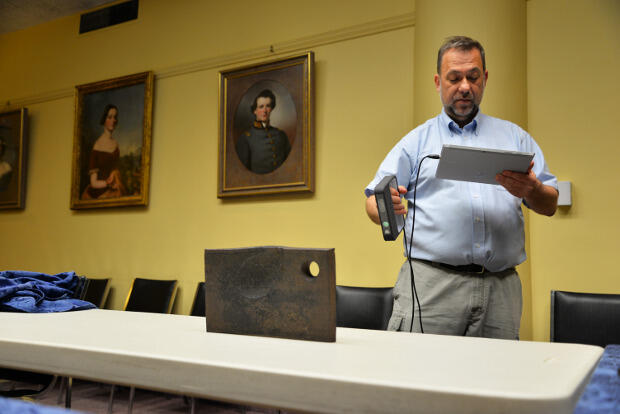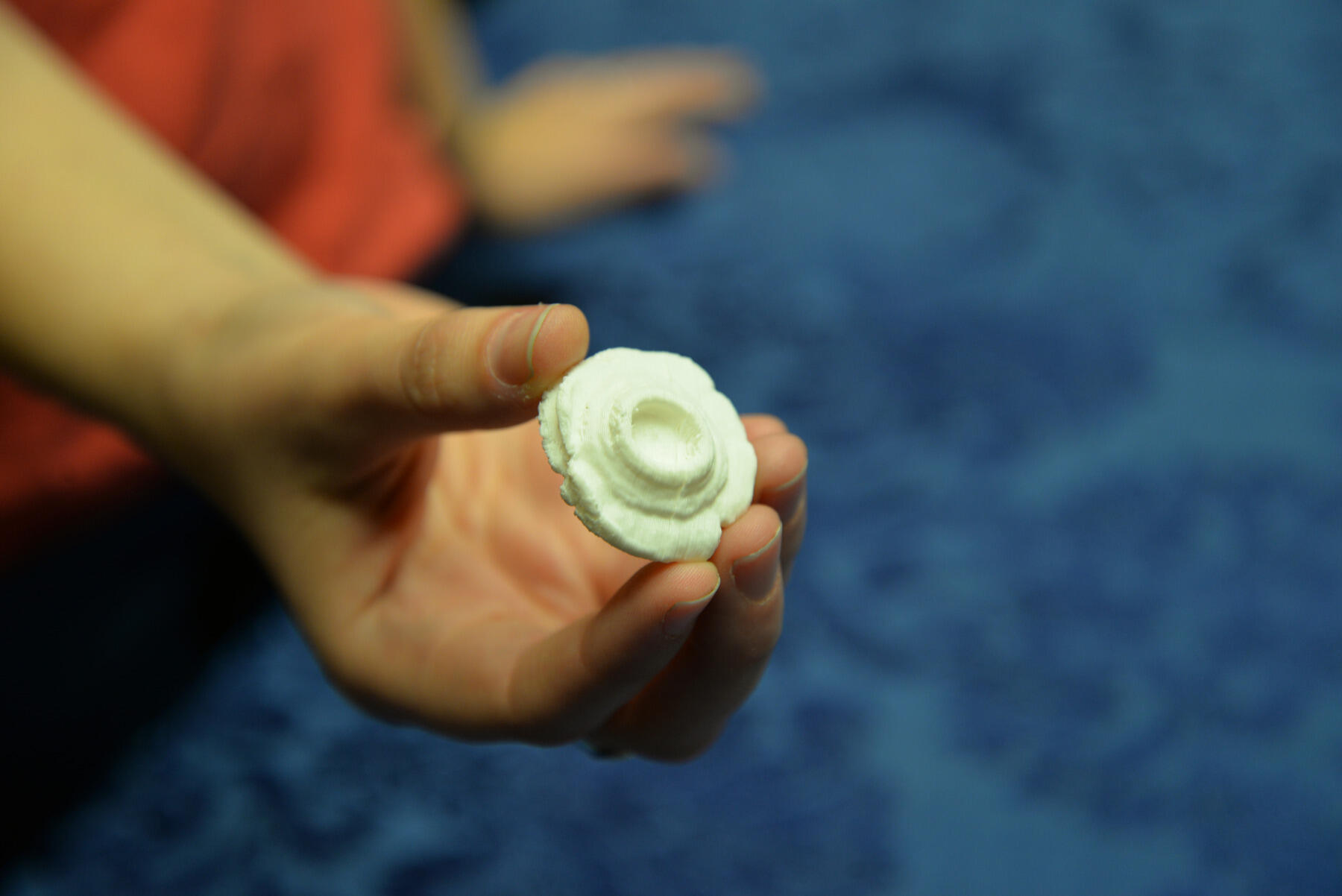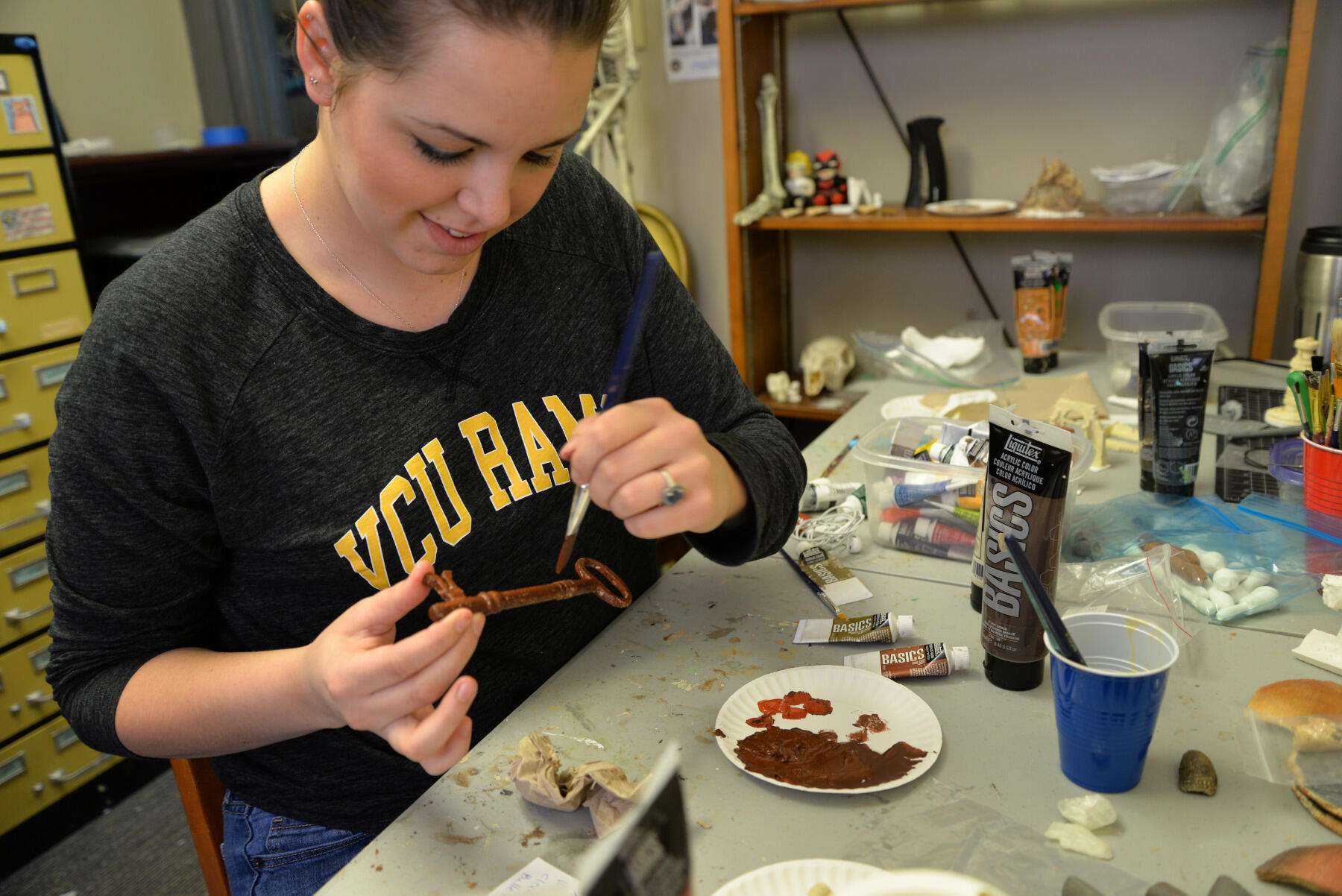
March 31, 2016
3-D-printed Civil War artifact replicas – including CSS Virginia armor test plate – to be displayed Saturday
Share this story
Over the past several weeks, Virginia Commonwealth University anthropology professor Bernard Means, Ph.D., has been visiting the American Civil War Museum in Richmond to 3-D scan some of the museum’s treasures, including a 1-inch thick iron plate that was shot with a cannon to test the armor of the ironclad CSS Virginia – better known as the Merrimack.
“This was the armor plating that was supposed to clad the entire ship,” Robert Hancock, the museum’s senior curator and director of collections, said as Means 3-D scanned the plate with a handheld device. “They basically built a mockup of the side of the ship and fired Brooke cannon at it to decide how well it would work. They realized that it probably wasn’t good enough, so they decided to go with 2-inch-thick plates.”

A 3-D-printed replica of the CSS Virginia test plate will be among a variety of 3-D-printed Civil War-era artifact replicas that will be displayed Saturday at the Civil War & Emancipation Day event at Historic Tredegar from 10 a.m. to 4 p.m.
At the event, anthropology students in the School of World Studies of the College of Humanities and Sciences will show 3-D-printed replicas from the American Civil War Museum’s collection, including a “rosette” that formed when a Union and a Confederate bullet collided in mid-air, a toothpick from a Confederate POW camp and the key to the Confederacy’s notorious Libby Prison in Richmond.
We want people to get a sense for the types of objects and for the shape of the objects that might be found in Civil War and pre-Civil War Richmond.
“We want people to get a sense for the types of objects and for the shape of the objects that might be found in Civil War and pre-Civil War Richmond,” said Means, director of VCU’s Virtual Curation Laboratory, which 3-D scans and prints historic artifacts for analysis, conservation and education.
The students will also showcase 3-D-printed replicas of objects made or used by enslaved people at George Washington’s Mount Vernon and Ferry Farm, James Madison’s Montpelier and Thomas Jefferson’s Poplar Forest, including ceramic vessels, wig curlers, and clay and stone smoking pipes.
Other 3-D-printed objects on display will include Civil War bullets and a rifle lock from a Springfield musket, among other items.
“They'll talk about 3-D scanning, preservation, 3-D printing and how all of this makes the Civil War and Emancipation heritage of Richmond available to anyone to study throughout the world,” Means said.

The American Civil War Museum is interested in exploring the possibilities of incorporating 3-D-printed artifact replicas into its educational programming. As Means scanned the CSS Virginia test plate, Hancock said a 3-D-printed replica would be useful to allow visitors to handle, even though they wouldn’t feel the full weight of the artifact.
“With something like this,” he said, “[the museum’s education staff] can’t hand it around to somebody. It’s a 30-pound plate. They’d drop it on their foot.”
Kelly Hancock, interpretation and programs manager for the museum, said 3-D-printed artifact replicas, such as the museum’s cannons, can offer visitors – particularly younger ones – a valuable hands-on experience.
“There are certainly people who are tactile learners, so it can make more of an impression when they can actually feel and touch [an artifact replica],” she said. “There’s something exciting about that, as opposed to just looking at something.”
For more details and a full list of activities at the Civil War & Emancipation Day event, visit: https://acwm.org/learn-and-do/programs-%26-events/special-events/CWED
Subscribe for free to the weekly VCU News email newsletter at http://newsletter.news.vcu.edu/ and receive a selection of stories, videos, photos, news clips and event listings in your inbox every Thursday.
Subscribe to VCU News
Subscribe to VCU News at newsletter.vcu.edu and receive a selection of stories, videos, photos, news clips and event listings in your inbox.










